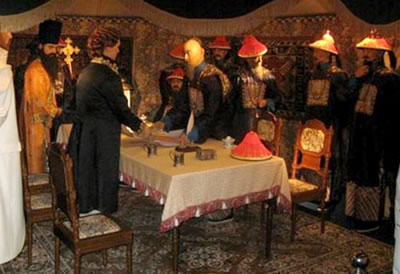 |
| Late Ming Dynasty |
The Ming dynasty of China (1368–1644) was founded by a commoner, Zhu Yuanzhang (Chu Yuan-chang), who ruled as Emperor Hongwu (Hung-wu), 1368–98. He expelled the Mongols and began the recovery of China.
His son, Emperor Yongle (Yung-lo), ruled from 1402 to 1424 and was also a capable general and administrator. Together they expanded China’s borders, strengthened the defenses, and pursued policies that led to economic recovery and agricultural revival.
The schools that they founded and the examination system that they revitalized to recruit government officials would serve the empire well during long decades when minors and weaklings occupied the throne. However a succession of capricious and weak rulers eventually led to eunuchs’ controlling power and massive corruption that resulted in domestic revolts, unwise foreign wars, and dynastic collapse.
Emperor Hongwu instituted an autocratic style of government and both he and Yongle exercised their power vigorously and effectively. However while Hongwu treated eunuchs as mere palace servants, Yongle began to entrust them with administrative duties, but under his firm control.
Yongle died leading his fifth campaign against the Mongols. His son was already ill and died within a year, passing the throne to his son, who ruled for 11 years as Emperor Xuande (Hsuanteh). Xuande was succeeded by his eight-year-old son in 1436.
Such short reigns were damaging in an autocratic system of government where continuity in leadership was an asset. Minors on the throne required regencies by empress dowagers, who notoriously relied on eunuchs rather than ministers for advice.
Most Ming dynasty eunuchs came from poor families in northern China and were noted for their greed and extortion. Boy emperors who were isolated from normal human contacts grew up dependent on them as friends and advisers.
For example Emperor Zhengtong (Cheng-t’ung) appointed his eunuch Wang Zhen (Wang Chen) commander in chief and the two men set out together in 1494 with a large army against the Mongol Esen Khan. The army was cut to pieces, Wang died, and Zhengtong was taken prisoner.
Although the Mongols were too weak to take the offensive, this disaster ended Chinese military superiority over the nomads and put the Ming government on the defensive on the northern frontier. In the mid-16th century, Mongol chief Altan Khan would raid China’s northern borders at will for two decades.
At the same time, Japanese pirates and Chinese renegades raided and looted the southern coast inflicting huge damage. In the 1590s, Japanese warlord
Toyotomi Hideyoshi invaded Korea. Suzerain China had to send a huge army to aid the Koreans for six years, at enormous cost.
Two long reigns in the 16th century (Jiajing or Chia-ching between 1520 and 1566, and Wanli (Wan-Li) between 1572 and 1620) brought a measure of stability, largely due to able ministers in the early part of each reign.
However both monarchs were grossly negligent of their duties, isolating themselves from government officials and relying on power-hungry palace eunuchs, with the result that the bureaucracy became increasingly demoralized. A government that was unresponsive to social and economic problems would eventually be brought down by peasant rebels from northwestern China led by Li Zicheng (Li Tzuch’eng) in 1644.
Ming China prospered, however, despite inept political leadership. The population increased from about 60 million at the beginning to possibly 200 million by 1600. In addition to great metropolitan centers such as Suzhou (Soochow) and Hangzhou (Hangchow), many intermediate-sized market towns emerged.
Society was egalitarian and the flourishing printing industry facilitated the spread of education so that the sons of millions of families could realistically aspire to obtain an education, pass the state exam, and join the elite.
Popular culture represented by the theater and opera flourished in the cities. In addition, a new genre of literature developed during the Ming. It was the novel, written in the vernacular and depicting men and women of all social classes.
The government’s principal source of income was the land tax, assessed on land owned by farming families and not on the number of males in a household. This system of taxation gave farmers greater freedom to choose employment and allowed the development of industries. Silk and cotton manufacturing prospered, as did the porcelain industry, which led the world.
While China had traded with South and Southeast Asia and beyond for over a millennium, the Portuguese entered the trading scene in 1516, opening direct seaborne Sino-European commercial relations.
Portuguese merchants were followed by men from the
Netherlands, England, France, and other European nations. Westerners brought European products, but more significantly New World crops such as maize, sweet potatoes, and tobacco, with enormous impact on Chinese agriculture and diet.
More immediately European demand for Chinese silks, porcelain, and tea brought an influx of silver to China. In 1581, the first Jesuit missionary landed in China. Jesuits would be important during the late Ming and early
Qing (Ch’ing) as cultural ambassadors between China and Europe.
They introduced Western sciences, mathematics, astronomy, cartography, and firearms to China and the ideals of Chinese philosophy to Europe, laying the foundations of Sinology, or study of Chinese civilization in Europe.
The 16th century was an kurun of great changes in Europe and China, where modern societies were beginning to develop. Despite inept Ming emperors the educational system and civil service continued to provide for a prosperous and advancing civil society.
However by the beginning of the 17th century, many signs pointed to the fact that the country was exhausted. An ineffective government could not simultaneously deal with internal rebellions and border incursions by nomads.
The last Ming emperor hanged himself as rebels swarmed into the capital; a beleaguered frontier general then invited the Manchus, a minority ethnic group living on the northeastern borders of the Ming empire, to help him put down the rebels. Astute Manchu leaders seized this opportunity to ascend the throne and founded a new dynasty.







